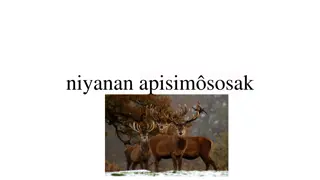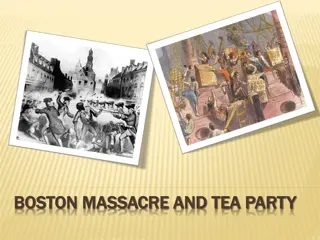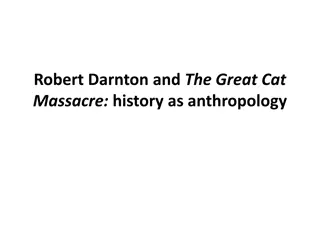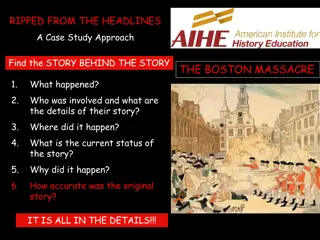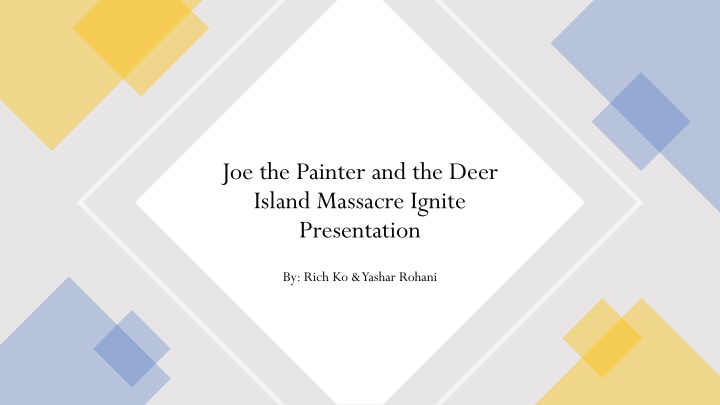
Exploring Irony and Character Development in 'Joe the Painter and the Deer Island Massacre' Presentation
Delve into the concepts of verbal, situational, and dramatic irony as portrayed in the ignite presentation of "Joe the Painter and the Deer Island Massacre." Analyze the evolution of characters like Joseph Ghoti and the Narrator, highlighting the nuances of their development throughout the story. Uncover unexpected twists and societal reflections in this thought-provoking narrative.
Download Presentation

Please find below an Image/Link to download the presentation.
The content on the website is provided AS IS for your information and personal use only. It may not be sold, licensed, or shared on other websites without obtaining consent from the author. If you encounter any issues during the download, it is possible that the publisher has removed the file from their server.
You are allowed to download the files provided on this website for personal or commercial use, subject to the condition that they are used lawfully. All files are the property of their respective owners.
The content on the website is provided AS IS for your information and personal use only. It may not be sold, licensed, or shared on other websites without obtaining consent from the author.
E N D
Presentation Transcript
Joe the Painter and the Deer Island Massacre Ignite Presentation By: Rich Ko & Yashar Rohani
Irony -Verbal When Joe responds to the narrator by referring to Portuguese fisherman, he does not mean they are talking about the fisherman. (King 106)
Irony Situational When given this information we assume the pageant by Joe will be based on a gruesome story of the First Nations people massacring Larson and his settlers. Later, we discover that the story is based around how Larson was a coward and massacred the First People at night. (King 108)
Irony - Dramatic While it may not be obvious to the narrator or those in the audience, we as the readers in modern time can deduce that the mayor was unhappy with the pageant due to it showing the town s gruesome as we have learned that people of the past were quite discriminative or prejudicial. (King 119)
(King 101) Types of Character - Round Joseph Ghoti:Vulgar and has no control over his level of tone, yells often due to working at a foundry for part of his life. He has a sincere and honest heart, sometimes too honest, and when he is interested in something he works his hardest to know everything about it, he won t do anything desultorily.
Ed Petersen: Ed is a character mentioned once in the story, and his interaction with Joe has no depth or detail whatsoever, it is a brief hello from Joe, and he is never mentioned again throughout the rest of the story. Types of Character - Flat (King 99)
Types of Character - Dynamic The Narrator: During the beginning of the story, it is obvious that the Narrator does not spend time with their family, dive into their own culture, or even know of the history on Deer Island regarding his culture. By the end of the story we see that the Narrator makes a significant change in the sense that he is more involved with his culture as a First Nations man and is spending more time with his family too. Another big change is his acceptance of Joe, in the beginning he sees Joe as someone he tolerates, but by the end of the story he talks about Joe as if he s his best friend. (King 107) (King 120)
Types of Character - Static Mayor: After having sat through an emotional play about the history of Deer Island, the mayor made no effort to reconcile, reflect or change in any way, or even shed light on the situation, even after the play he didn t change in any way. He in fact did not like the play due to it shedding a bad light on Deer Island. (King 119)
Types of Characters - Stock The Narrator s Father: The narrator, who is First Nations, has a father who embodies the entire culture, replying to things with Ho and mentioning the good old days (King 110) when talking about everyone s camps being set up. The Narrator s Father fits the stereotype for the First Nations man, and that is his main trait throughout the story, which makes him a stock character. (King 110)
Symbolism - Literal In the title the word Massacre is to symbolize the main driving point of Joe s pageant.
Symbolism - Figurative Joe s pageant was a symbol for how performances and media can help spread awareness or share stories to others to help those in need.
Foreshadowing In the name Joe the Painter and the Deer Island Massacre the title itself foreshadows how events in the story play out, with the play they re performing in ending with the representation of the massacre led by Matthew Larson against the First Nations People. The title could also foreshadow how Joe s work of art (the play) would end up in a massacre in the figurative sense, with the townspeople not liking the play, and especially the mayor, finding it to be a negative outlook on Deer Island s history. Lastly, the play in the story is referred to as Matthew Larson and the Deer Island Massacre , so switching Joe s name for Matthew s could foreshadow how Joe plays Matthew in the actual play. (King 107)
Conflict - Internal During the story, the Narrator has doubts about Joe s play. Throughout the play, the Narrator and his family enjoy their time and the Narrator sees that Joe truly just wants to represent the history of the First Nations People and Deer Island, and his doubts for the play go away so the conflict is resolved. (King 111)
Conflict - External The external conflict in this story could be seen as Person vs Society , because the Narrator partakes in a play for a pageant and in the end, he does not win the pageant due to their play being deemed inappropriate by their society. There was another play that was deemed inappropriate, and we can only assume that was due to their society having strict outlooks on what is acceptable and what isn t, societal rules that leave no room for reconciliation or light being shed on anything other than the happy point of view they want for Deer Island. (King 120)
Plot Introduction/Initiating Incident We are introduced to Joe the Painter, a loud and honest man, by the narrator who Joe calls Chief . Joe brings the narrator to a bar to explain his plans for a pageant for the contest. Joe wants to perform a pageant of how the town was founded by Matthew Larson and mentioning a massacre. Asking the narrator to bring in 30 to 40 First Nations people.
Plot Rising Actions The narrator, despite being against being in the pageant at the time, gathers his family and relatives to perform in the pageant. As they rehearse and perform, the narrator discovers they are enjoying spending time with their family.
Plot - Climax The pageant was going great. Tension was building up as the final as Joe leads a group of actors to portray Larson attacking at night. After the performance everyone is silent.
Plot Falling Action When the performance is over the crowd is silent. Slowly the crowd erupts into applause. A select few are seen as unhappy including the mayor by the performance.
Plot - Conclusion The committee deemed Joe s pageant inappropriate showing how the committee and the mayor were unhappy with Joe revealing the gruesome truth of Matthew Larson s cowardice.
Theme It is important to educate people on the histories of things in their life so that they may not only appreciate what they have, not be ignorant or overconfident with these things, but to also not repeat the same mistakes.
Moral It is unacceptable to avoid the dark history of your homeland s past, especially as a proud member of your society. It is important and morally right to reconcile and reflect on that dark history rather than putting it under the rug and being oblivious to it.






